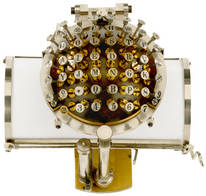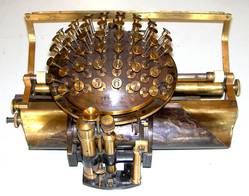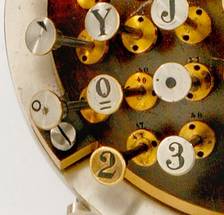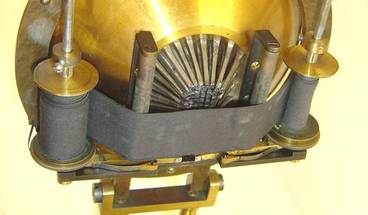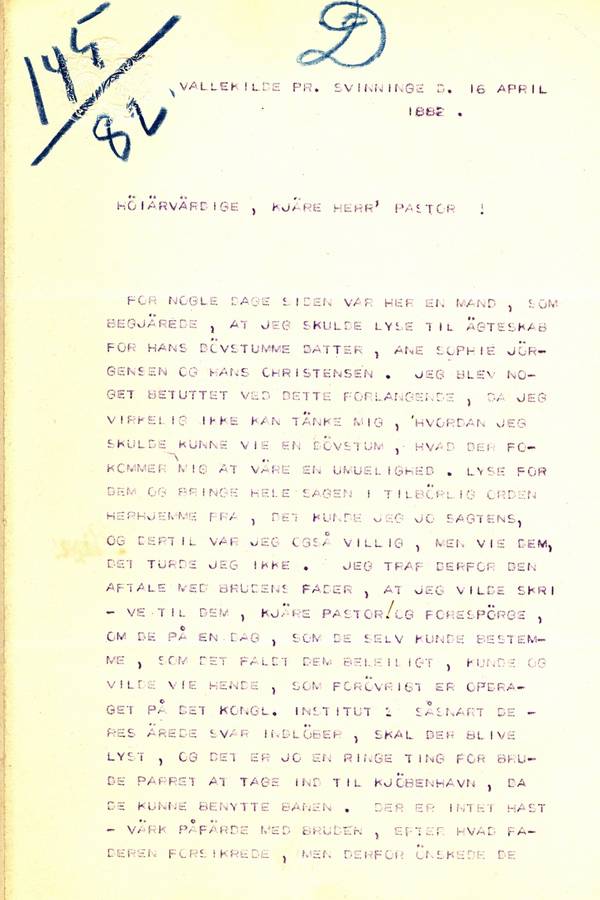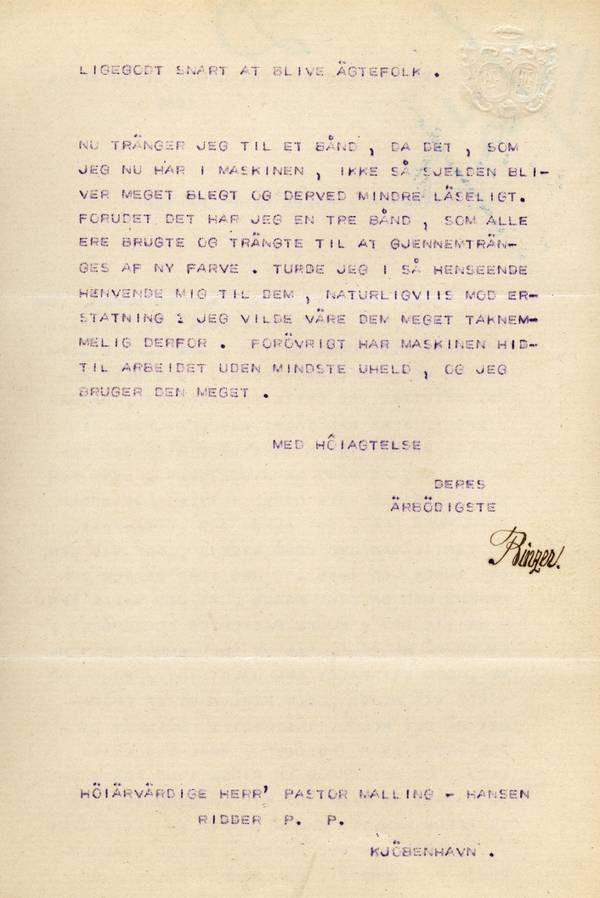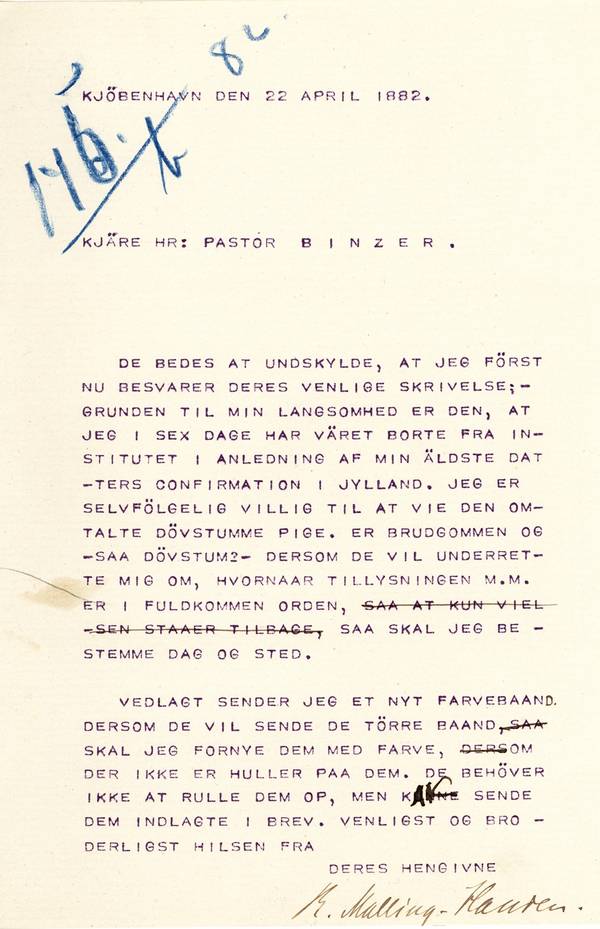1882.04.22 To Reverend Binzer
The first letter shown here, was actually not written by RMH himself, but by an old friend of him, reverend Binzer. But the reverend had his own writing ball, and this makes this a very rare letter. RMH's answer is shown further down on the page.
VALLEKILDE BY SVINNINGE, APRIL 16, 1882[1]
DEAR REVEREND MR HANSEN,
HONOURABLE SIR,
A FEW DAYS AGO A GENTLEMAN SHOWED UP AND REQUESTED ME TO ANNOUNCE THE BANNS FOR HIS DEAF-MUTE DAUGHTER, ANE SOPHIE JÖRGENSEN WITH HANS CHRISTENSEN. I WAS SOMEWHAT PERPLEXED BY THIS REQUEST, NOT HAVING THE SLIGHTEST IDEA HOW I CAN POSSIBLY MARRY A DEAF- MUTE PERSON, AND IT DOES APPEAR IMPOSSIBLE TO ME. OF COURSE I CAN PUBLISH THE BANNS.AND PREPARE THE WHOLE CEREMONY AND THE PAPERWORK, AND I AM QUITE WILLING TO CATER FOR ALL OF THAT, BUT THE ACTUAL MARRIAGE CEREMONY I DARE NOT TAKE ON. THEREFORE I AGREED WITH THE BRIDE’S FATHER THAT I WOULD WRITE TO YOU, DEAR REVEREND, AND INQUIRE WHETHER YOU WOULD BE WILLING TO MARRY THE GIRL ON A DAY OF YOUR CONVENIENCE AND CHOICE. INCIDENTALLY, SHE HAS BEEN EDUCATED AT THE ROYAL INSTITUTE. AS SOON AS YOUR HONOURED RESPONSE HAS BEEN RECEIVED, WE SHALL ANNOUNCE THE BANNS AND IT IS, OF COURSE, A VERY SMALL INCONVENIENCE FOR THE YOUNG COUPLE TO TRAVEL TO COPENHAGEN&, SINCE THEY CAN USE THE RAILWAY LINE[2]. ACCORDING TO THE ASSURANCES OF THE FATHER, THERE IS NO URGENCY IN THIS MATTER[3], YET THEY DO WISH TO MARRY SOON.
PRESENTLY I NEED A RIBBON[4], SINCE THE ONE I AM USING AT THE MOMENT OFTEN TURNS VERY PALE AND HENCE LESS READABLE. IN ADDITION, I HAVE THREE OTHER RIBBONS, ALL USED AND IN NEED OF BEING REFRESHED WITH NEW INK. MAY I TAKE THE LIBERTY TO TURN TO YOU WITH THIS REQUEST, - EVIDENTLY AGAINST COMPENSATION. I WOULD BE EVER SO GRATEFUL. BY THE WAY, THE MACHINE HAS SO FAR BEEN WORKING WITHOUT THE SLIGHTEST MISHAP AND I USE IT A LOT.
RESPECTFULLY[5] YOURS
Binzer
HONOURABLE REVEREND MR MALLING-HANSEN[6]
KNIGHT P.P.[7]
[1] CB: This letter was typed on the writing ball, however NOT by RMH, but by a ‘Reverend Binzer’, probably the vicar of the village of Vallekilde, situated in the north-western part of the island of Sealand (in Danish: Sjælland), around 90 kms from Copenhagen. Mr Binzer is not mentioned in any of the major encyclopedias, nor in Google. We don’t know which versions of the writing ball he is using, but this is the first – and, so far (Dec 2008) - the only letter typed on the writing ball apart from those written by RMH or Nietzsche! RMH replies in a letter marked 18820422UK.
It is noteworthy that in the Danish original the document includes the letter ‘Å’ – a letter which was normally written as ‘AA’ at the time (the vowel sound is very close to English: ‘low’). RMH was ahead of his time – the letter ‘å’ officially replaced ‘aa’ only as from 1948!
[2] CB: This is a period in which the railway network in Denmark is being rapidly extended; he is probably referring to the line linking Copenhagen and Kalundborg, passing by Holbæk.
[3]CB: In other words: she is not pregnant! At the time, frequently a pressing reason to get married urgently.
[4] CB: Sverre and Dieter: This user of the writing ball is in need of new ink for his ribbons?? This appears to be a VERY important technical problem, to which I have never given any thought. Perhaps yet another explanation why the writing ball did not meet with success?? The very first version of the writing ball used, as we know, carbon paper of a type that – as far as I know – was already in use for copying handwritten letters and therefore available everywhere. However, the manual writing ball after 1878 used ribbons. And how did they refresh such ribbons with new ink? RMH did not have local agents or technicians close to his customers, so how did the customers acquire new ribbons? Were they mailed to them, and was it for them to unscrew the ribbon holder on the writing ball and exchange the ribbon??? The task must have required an instrument maker? Or – could the users remove the ribbon and refresh it – apparently also an option? That seems to have been a cumbersome procedure? Or, could the customers refurbish the ribbons by sending them to RMH? How to remove the ribbon and to spool it again? These are also questions where Dieter and Uwe need to be consulted.
[5] CB: It is remarkable that the original text uses a the letter O with a circumflex: ‘Ô’ to render the normal vowel Ø.
[6] CB:Interestingly enough, Mr Binzer is using the hyphen in RMH’s surname! We were under the impression that RMH introduced this spelling in 1883?
[7] CB: ‘P.P’ is an abbreviation for ‘all other titles and decorations’
COPENHAGEN APRIL 22, 1882
DEAR REVEREND MR B I N Z E R .[1]
MY SINCERE APOLOGIES THAT I HAVN’T REPLIED BEFORE NOW TO YOUR KIND LETTER: - THE REASON FOR MY TARDINESS BEING THAT FOR SIX DAYS I HAVE BEEN ABSENT FROM THE INSTITUTE ON ACCOUNT OF MY ELDEST DAUGHTER’S CONFIRMATION IN JUTLAND[2]. OF COURSE I WILL BE HAPPY TO MARRY THE DEAF-MUTE YOUNG WOMAN[3]. IS THE BRIDEGROOM ALSO A DEAF-MUTE? – IF YOU WILL KINDLY LET ME KNOW WHEN THE PUBLICATION OF THE BANNS ETC ARE IN ORDER AND DONE WITH ETC ETC, I SHALL DECIDE ON THE PLACE AND THE TIMING.
ENCLOSED PLEASE FIND A NEW RIBBON. IF YOU SEND ME THE DRY RIBBONS I SHALL REFRESH THEM WITH NEW INK[4], IF THEY ARE NOT PERFORATED. YOU DON’T NEED TO UNWIND THEM, JUST SEND THEM IN AN ENVELOPE. MY VERY BEST AND BROTHERLY GREETINGS FROM
YOUR DEVOTED
R. Malling-Hansen[5]
[1] CB: The printing quality of this letter is amazingly good! It is RMH’s response to reverend Binzer’s letter 18820416dk.
[2] CB/SA: This is puzzling, since the eldest daughter, Juliane, was born in 1866? Why wasn’t she confirmed at home by RMH himself? And why does the ceremony take place as late as that, when she is 16 years old?
[3] CB: Considering that the young woman has been a pupil of RMH’s institute, it is somewhat odd that he does not mention anything about remembering or knowing her. She must have attended the institute during his tenure?
[4] CB: Unfortunately, this sentence clearly shows that RMH did not have any supply chain whatsoever. Are we to understand that RMH personally does the re-inking of the ribbons, refreshing them with Prussian Blue and supplying them to his few customers??? It does appear somewhat inane – the failure of the set up is evident! Where is agent Ritzau in this context, for instance?
[5] CB: Sverre: RMH’s name is spelled with a hyphen here; isn’t that the first time we meet that kind of spelling?
SA: Sporadically he did use a hyphen in his signature before 1883, and this letter is probably among the very first documents where the signature is hyphenated. As far as I have been able to register, he consistently signed with a hyphen after 1883.

- In 1883 Binzer, just like RMH, wrote a letter to teacher and author Anders Petersen - author of the book about the Jonstrup teachers training school. Evidently Binzer had also been a student at this school. Only one of the pages of this letter exists today, and unfortunately Binzer did not use his writing ball when writing it

